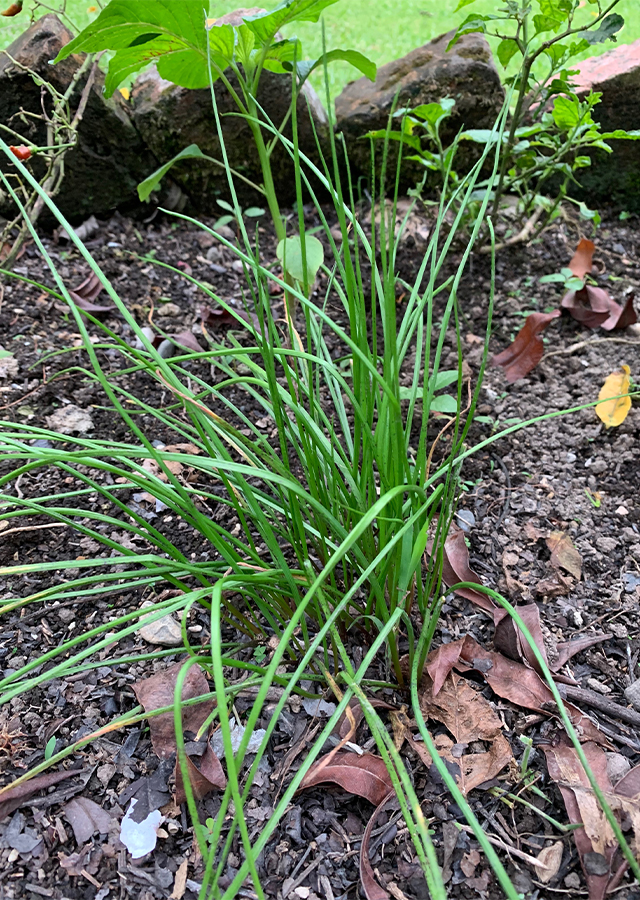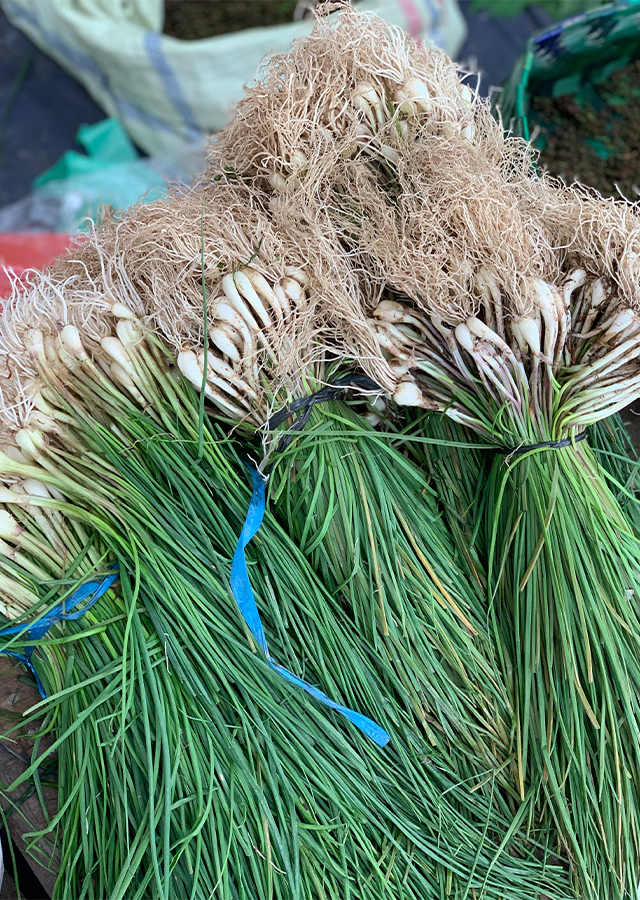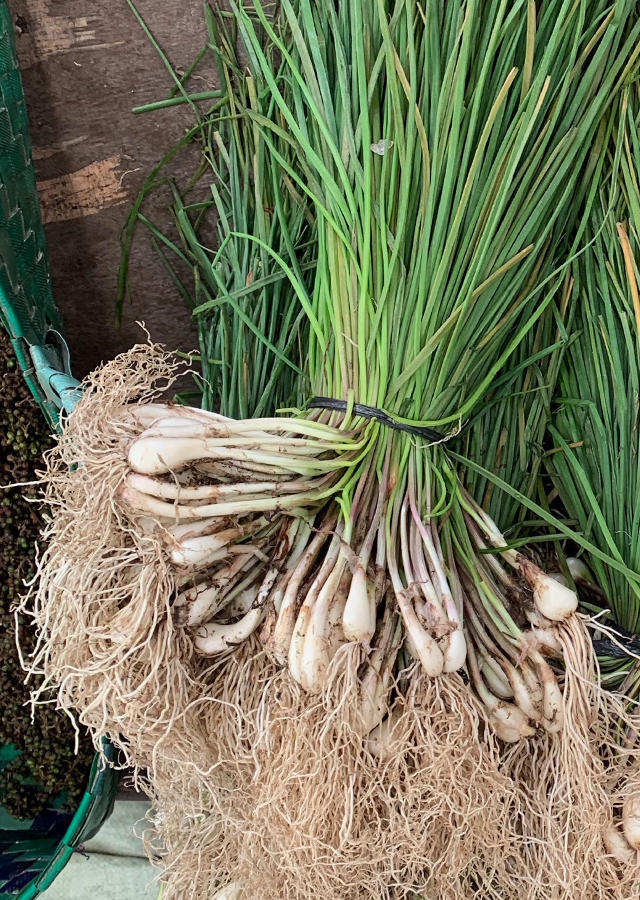Chinese Onion
Allium chinense G. Don
Amaryllidaceae
Location in our garden
Vegetable



Synonym
Allium bakeri Regel
Allium bodinieri H.Lév. & Vaniot
Allium exsertum G. Don
Habitus
Herbaceous. Evergreen perennial herbaceous plant, grows up to 30 cm tall
Part Used
The Whole Plant
Growing Requirements
Full Sunshine
High Rainfall
Habitat
Grassland
Overview
Chinese onion or Rakkyo is native to central and eastern China. It is widely grown in China and Japan, to a limited extent in South-East Asian countries, and probably in private gardens of Japanese and Chinese people in many other parts of the world. A popular vegetable in east Asia, where it is widely cultivated for its edible bulb and leaves, and is often sold in local markets.
Vernacular Names
Lokyo (Malay), Krathiam-chin (Thai), Kiệu (Vietnamese), Rakkyo (English).
Agroecology
Chinese onion or Rakkyo is best adapted to intermediate latitudes (30°-40° N and S). The optimal temperature range for bulb formation is 15-25 °C. Rakkyo requires a well-drained soil, preferably not fertile (e.g. sand dunes). In fertile soils such as clay loam or volcanic ash, growth is too vigourous, resulting in too large and soft bulbs.
Morphology
- Bulbs - ellipsoidal, 2-4 cm × 7-15 mm, at top gradually tapering into the leaf-blades; protective bulb-coat leaves several, membranous, white to purplish; after planting.
- Stems - terete, solid, up to as long as the leaves and 2 mm wide.
- Leaves - distichous, conical-cylindrical, 20-40(-60) cm × 1-5 mm, hollow, 3-5-ridged, D-shaped or nearly triangular in transverse section. The leaves are slender, hollow and thin- walled like those of chives, but differ in that they are 3- to 5-angled (i.e., not so smoothly round), less stiffly erect, and are bright-green rather than blue-green
- Flowers - umbellate, 6-30-flowered, without bulbils; spathe 2-lobed, persistent, hyaline; pedicel 1-3 cm long; flowers campanulate, purplish, tinged with red; tepals 6 in 2 whorls, 4-5 mm long; stamens 6, much longer than the tepals; inner 3 filaments with broadened bases and each with 2 short teeth. The flowers are lavender with long pedicels, obtuse perianth segments and long-exserted styles and stamens.
Cultivation
- Propagated by seeds and by division.
- Sow in containers. Prick out the seedlings into individual pots when they are large enough to handle. Plant them out into their permanent positions once they are growing vigorously and are large enough.
Chemical Constituents
Steroidal saponin, polifenol, flavonol (quercetin, quercetin glycosides), saponin (xiebai-saponin I, laxogenin, aglycone, isoliquiritigenin, ß-sitosterol glucoside), essential oils.
Traditional Medicinal Uses
- Medicinally, the bulbs are of interest in the prevention of thrombosis. They are used for the treatment of heart failures in Chinese medicine. Rakkyo is also used against fever, stomach-ache and eye infections.
- The whole plant is astringent, carminative and expectorant. It is used in the treatment of stuffiness sensation and pain in the chest, angina pectoris, pleurisy, bronchitis, diarrhoea and tenesmus in cases of dysentery.
- Help reduce blood cholesterol levels, act as a tonic to the digestive system and also tonify the circulatory system.
- The plant is traditionally used to treat stenocardia, heart asthma.
- Reduces PMS symptoms, helps prevent or treat allergies.
Part Used
Reference Sources
- Fern, Ken. (2014). Useful Tropical Plants: Allium chinense. http://tropical.theferns.info/viewtropical.php?id=Allium+chinense. 16-01-2021.
- Pl@nt Use. (2016). Allium chinense (PROSEA) https://uses.plantnet-project.org/en/Allium_chinense. 16-01-2021.
- Ping Lin, Y., et.al. (2016). Antihyperlipidemic activity of Allium chinense bulbs. Journal of Food and Drug Analysis. https://www.sciencedirect.com/science/article/pii/S1021949816300217. 16-01-2021.
- PROSEA 1994. Allium chinense. In: Siemonsma, J.S. and Piluek, K. (Editors): Plant Resources of South-East Asia No 8. Vegetables. Prosea Foundation, Bogor, Indonesia. pp 71 – 73. 15-11-2021.
- Mann LK & Stearn W 1960. Rakkyo or Ch'iao T'ou (Allium Chinense G. Don, Syn. A. Bakeri Regel) A Little Known Vegetable Crop. Economic Botany, Jan. - Mar., 1960, Vol. 14, No. 1 (Jan. - Mar., 1960), pp. 69-83. https://www.jstor.org/stable/4252138. 15-11-2021.

